You will love Le Jardin Agapanthe in Normandy, France. Or you will hate it.
But it’s not like most other gardens you’ll visit. There are no lawns, borders or views (although plenty of focal points).
Le Jardin Agapanthe is two classic Normandy houses, each surrounded by a garden. They’re divided by a road. Together, the two gardens are just over two acres, so they are ‘middlesized’. You could take this gloriously over-the-top design approach in much smaller gardens, too.
The two houses are glimpsed as if in a fairy tale, through abundant planting or round a corner, always tantalising, never wholly revealing themselves.

You are just a few feet away from the house, but you will only glimpse it through the garden foliage.
Marrying classicism with exotic fantasy
Le Jardin Agapanthe was created by French ‘non-conformist’ landscape architect, Alexandre Thomas. It’s in Normandy, France, but there are lessons for gardeners everywhere in its strongly structured planting and maze of paths, walls, waterfalls and terraces.
You discover the house when a path takes you there, and opens up a dramatic scene. I love the way the red foliage echoes the brick wall.
So what tips can an amateur gardener of a middle-sized garden take away from Le Jardin Agapanthe?
Winding paths instead of lawn

There’s no lawn in the two-and-a-half acres of the Jardin Agapanthe, just winding paths of river sand through lavish planting.
This is the third garden without a lawn that I’ve written about this year. The other two were Stephen Ryan’s tropical garden in Melbourne, Australia and Steven Edney and Lou Rawle’s exotic garden in rural Kent. Is this a new trend or do large no-lawn gardens inevitably spell exoticism?
Le Jardin Agapanthe can’t wholly be described as ‘an exotic garden’, although there is an element of jungle about it. Alexandre Thomas describes it as ‘marrying classicism with exotic fantasy.’ It’s planted with many northern-climate plants – conifers, hydrangeas, box, phlox, choisya and ferns, as well as hardier versions of palm, cordyline and bamboo.
The path and ground is covered with ‘river sand,’ with stone steps and pavers set into it.
Garden vertically as well as horizontally
The landscape in Normandy is either gently sloping or flat. There’s a book of photos showing the development of Le Jardin Agapanthe. Both houses could originally be seen from the road, and were surrounded by a flat lawn.

These are planted on the edge of a ‘crater’, created near a basement entrance. The sloping sides show off the structure of the plants – you wouldn’t see the shapes so well if this was all planted on the flat.
It’s not just the planting that’s turned the two houses into secret castles, with turrets and dormers just visible above the trees. It’s also Thomas Alexandre’s superb use of different levels.
His garden makes use of vertical as well as horizontal space. The book of photos reveals some massive earth-moving, creating craters, slopes, low hidden terraces and a sense of adventure.
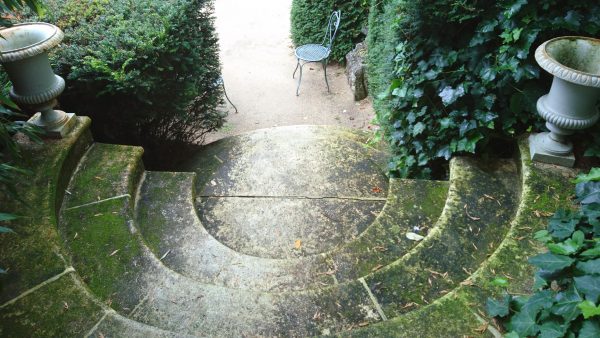
Steps go up and down, leading you onto the next dramatic scene.
Earth-moving is expensive, but Thomas Alexandre says that different levels in gardens create an illusion of space. Paths and steps lure you up or down. Terraces and walls open out or enclose your view.
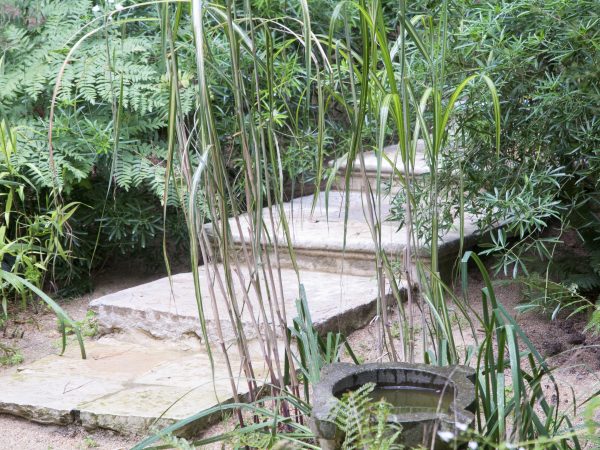
And these are the steps down the side of the ‘crater’ (my words – I’m sure there’s a more elegant way of describing it). These gently sloping sides show off layers of plants.
Every path leads to a (theatrical) destination
There are small signs showing you how to follow the paths around the garden. Each path leads to – and then from – a dramatic scene, beautifully staged. It might be an urn, judiciously placed. Or a private terrace with chairs and tables. You will find pillars and gates, a pond or a waterfall, each framed with the planting.

One of the many delightful seating areas at Le Jardin Agapanthe. This approach would suit anyone wanting to create a private dining area in their garden – use lavish planting to protect yourself from your neighbours’ eyes.
Beautiful garden furniture
This is not a rattan furniture look. Le Jardin Agapanthe rocks opulent French garden furniture in a big way.
Alexandre Thomas collects and sells antique and vintage garden furniture from Le Jardin Agapanthe’s ProAntic page. It’s not cheap – think 500 euros (or much more) for a pair of chairs, but they are such beautiful chairs!

Another charming terrace created by altering the levels. The retaining wall adds to the sense of privacy and gives the terrace texture. Wrought iron French bistro chairs in soft, historic colours and an unusual style of teak bench add atmosphere.
You can find cheaper versions, such as this Charles Bentley bistro set or French Antique Green bistro set from Amazon (affiliate links – you can click through to buy. If you do, I may get a small fee.)
Junk shops and auction rooms are also a good place to buy pretty garden furniture, although prices have risen considerably in the past few years. If buying online, look for the description ‘wrought iron’ rather than ‘cast aluminium’ which tends to be less solid.
Clever ways with pots
There are two ways with pots in this garden. The first is to buy beautiful large pots, then leave them empty. Such pots are not cheap, so check that they are frostproof.
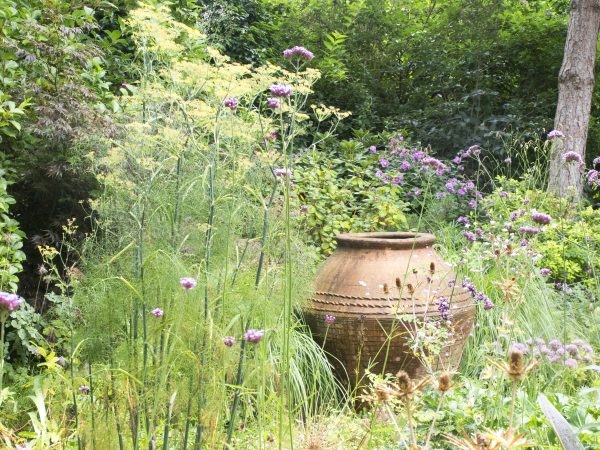
A large beautiful pot, left empty, creates a punctuation point in the garden.
The second way is to treat pots as vases, filling them with cut flowers or small plants and swapping them over regularly. As it can be difficult to keep smaller pots and troughs looking good when they’re planted up, I think this is a very cunning approach.
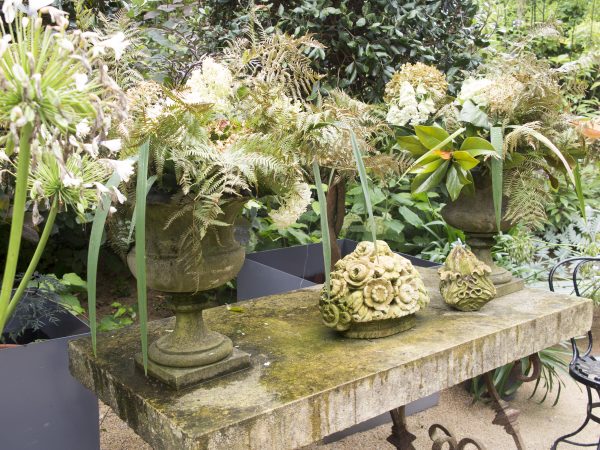
Urns treated more like vases and filled with greenery and cut flowers.

A vintage window box filled with cut flowers. Charming.
Foliage is the main story
One TripAdvisor reviewer for this garden complained that she had visited late in the year, so the garden was largely ‘over.’ Coincidentally, this was an August review and I, too, visited in August.
The most breath-taking part of this garden isn’t the flowers, but the foliage and structure of the planting, and the way they work together. To worry about flowers being ‘over’ is to misread the garden.

Not a flower in sight, just unusual or sculptural planting, and contrasting foliage colours.
The discreet charm of delicate colour
There are, in fact, lots of flowers at Le Jardin Agapanthe. Alexandre Thomas is a collector of unusual plants. We were especially won over by the range of different hydrangeas, in full flower – anyone who thinks that hydrangeas are dull, suburban plants should visit the gardens of Normandy in August.

Does anyone know what this delicately pretty hydrangea is called?
While many exotic gardens use powerful colour for impact, Le Jardin Agapanthe’s palette is soft and romantic, with shades of pink and purple. There’s lots of white too, scattered through the garden like fairy dust.

We hadn’t seen this one before – Hydrangea quercifolia ‘Snowflake’ has charming double flowers.
There were charming roses, too.

A froth of soft vintage pinks and purples – the use of colour is delightfully restrained.
Combine a stream and a path
This is a clever idea. One path is a stream, with stepping stones in it. The water trickles past your toes, but your shoes stay dry.
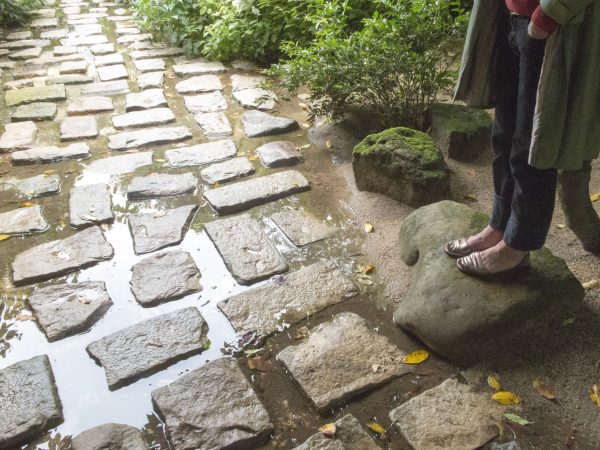
We loved this path-cum-stream. Although one TripAdvisor reviewer complained that the stepping stones made it difficult to walk round the garden in high heels. Are people mad? (Though most reviews were very enthusiastic)
Beautiful gates make a gorgeous garden
This is certainly not one of the Middlesized Garden’s money-saving posts (sorry about that).
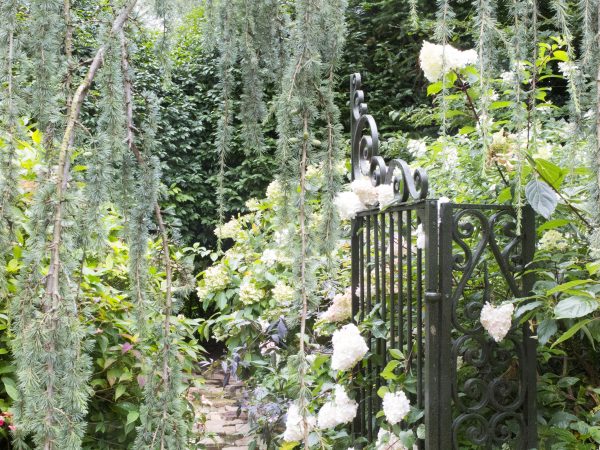
This gate separates out one area of the garden from another. I love it.
I often try to highlight the money-saving tricks other gardeners tell me about. But sometimes it’s worth spending money and getting something right. The gates at Le Jardin Agapanthe are antique gates, and the photo album shows several of them being brought onto site.
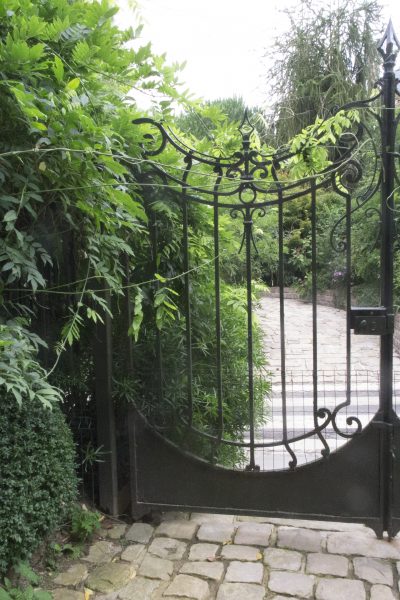
This gate leads across the road which separates the two halves of Le Jardin Agapanthe. I like the way wisteria has been allowed to wind its tendrils around it. You can still open the gate.
You might be lucky enough to inherit a good garden gate, but if not, it’s often worth making a big investment to create the ‘wow’ factor for both your house and garden. Over-sized gates can make a dramatic entrance, although I’ve seen a few mistakes in the gate department in British gardens.
And it’s a very personal garden…
Le Jardin Agapanthe is possibly one of the most acclaimed gardens in the world, but it’s still very personal. Alexandre Thomas’ mother sells the tickets at the entrance, takes garden tours and will show you the album of photos if you’re interested.

We heard the sound of a door closing, and Alexandre had vanished….
We caught a glimpse of Alexandre himself, too, whisking past with a pot and inviting us to shelter from the rain. (We’d have liked to ask him some questions, but he disappeared round a corner, and we heard the sound of a door closing.)
My mother would not have liked Le Jardin Agapanthe. She would have preferred open lawns and traditional borders of floral colour.
We loved it.
But either way, you won’t regret visiting it.
Le Jardin Agapanthe can be found in the Normandy tourism brochure Parks & Gardens.
Pin for later:
The post Le Jardin Agapanthe – love it or hate it, but don’t miss it! appeared first on The Middle-Sized Garden.
from The Middle-Sized Garden http://www.themiddlesizedgarden.co.uk/le-jardin-agapanthe/
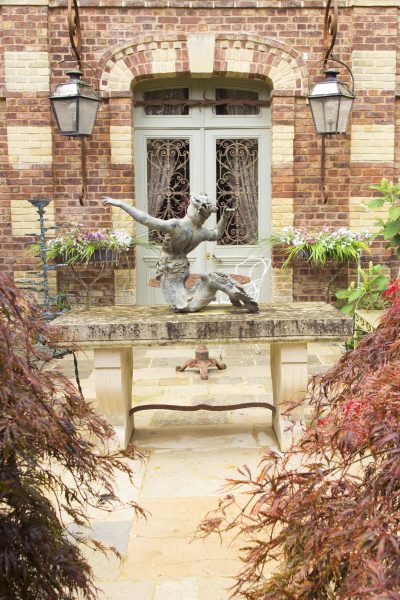

No comments:
Post a Comment